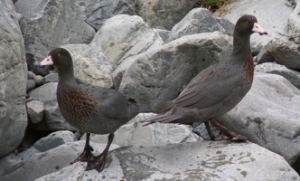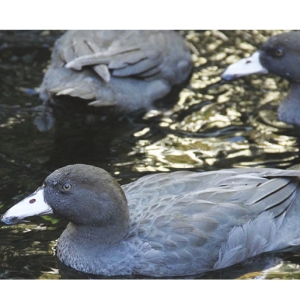Displaying items by tag: WHIONE programme
Whio Forever
Whio Forever wins green ribbon award
The Whio Forever recovery programme won the Ministry for the Environment Green Ribbon Award this year for protecting our biodiversity.
The Awards recognise outstanding contributions of individuals, organisations,
businesses and communities to protecting and enhancing New Zealand’s environment.
The National Whio Recovery Programme is a partnership between Genesis Energy, the Department of Conservation, Forest and Bird and the Central North Island Blue Duck Charitable Trust. It is focused on the protection and recovery of the whio, a threatened native bird and supports whio security and recovery
sites across the country.
Genesis Energy Environmental Manager, Bonny Lawrence and the Department of Conservation Whio Recovery Group Leader, Andrew Glaser accepted the award from the department’s Director General, Lou Sanson.
eight security sites Receiving the award DOC’s Whio Recovery Group Leader Andrew Glaser said it was exciting the Whio Forever partnership was
acknowledged, as the Awards recognised a wide range of amazing environmental initiatives around New Zealand.
Andy also acknowledged the many whio practitioners and community supporters
who have contributed to the success of the programme.
The whio recovery programme also funds WHIONE projects (Whio Operation Nest Egg) that allows wild whio populations to be boosted with ducklings hatched and raised in safe havens, then released into the wild.
Whio in decline
Whio in decline…
The whio (blue duck) is one of New Zealand’s ancient endemic waterfowl species and is classified as Threatened (Nationally Vulnerable) in the New Zealand Threat Classification System 2012, and listed as Endangered on the IUCN Red List of Threatened Species.
North Island and South Island whio populations are genetically distinct (though they are not described as sub-species) and are treated as separate management units. The whio has experienced rapid declines (particularly in the South Island) in abundance and distribution, nowhere common. It lives at low densities in severely fragmented populations. The most recent estimate of total population numbered 1200 pairs at most.
The most notable decline driver comes from introduced mammalian predators, with predation of eggs, young and incubating females. Stoats are the most significant threat and stoat control is a main focus of management activities.
The blue duck’s widespread decline throughout South Island beech forests areas has highlighted the insidious effects of mast-seeding beech trees, which result in great predation pressure, as rodent populations explode, causing a lagged increase in stoat populations which seek alternative prey when rodent numbers crash. A malebiased sex-ratio throughout the range, indicates that predation during incubation is significant.
One of the major conservation management tools for whio is captive breeding for release into the wild. The blue duck has been held in captivity for many years, and its husbandry requirements are understood. The aim is to maximise productivity of the captive breeding programme, and ensure that captive-bred ducklings are released at the highest priority sites. Captive breeding has proven highly effective, and is vital in aiding the recovery programme with the re-establishment and rebuilding of viable populations throughout the former range.
The Isaac Conservation and Wildlife Trust provides the largest output of blue duck juveniles annually, with its waterfowl aviaries being the most successful captive breeding enclosures in New Zealand for North Island blue duck. The Trust currently holds two North Island blue duck breeding pairs. These breeding pairs can lay up to three clutches per season, with an average of six eggs per clutch. All eggs are collected for incubation and hand rearing.
The Trust is a significant participant in the WHIONE programme, which consists of retrieving wild eggs each breeding season from South Island pairs for artificial incubation and rearing in captivity, with a subsequent release of juveniles once fledglings have been hardened in our fast water facilities and are at a lower risk of predation. Releases take place in natal territories or at new sites around the South Island to increase numbers and genetic diversity across sites or re-establish lost populations. Since 2016 the Trust has been retaining cohorts of South Island blue duck juveniles for flock mating, to initiate a captive breeding population across several South Island facilities. The Trust will move out of North Island birds and hold three pairs of the South Island blue duck.
Each season for the last 12 years, the Trust has also received North Island blue duck juveniles bred by other captive institutions nationwide, which are transferred for pre-conditioning in fast flowing raceways prior to release into the wild.
Sabrina Luecht
Wildlife Project Administrator
The Isaac Conservation and Wildlife Trust


